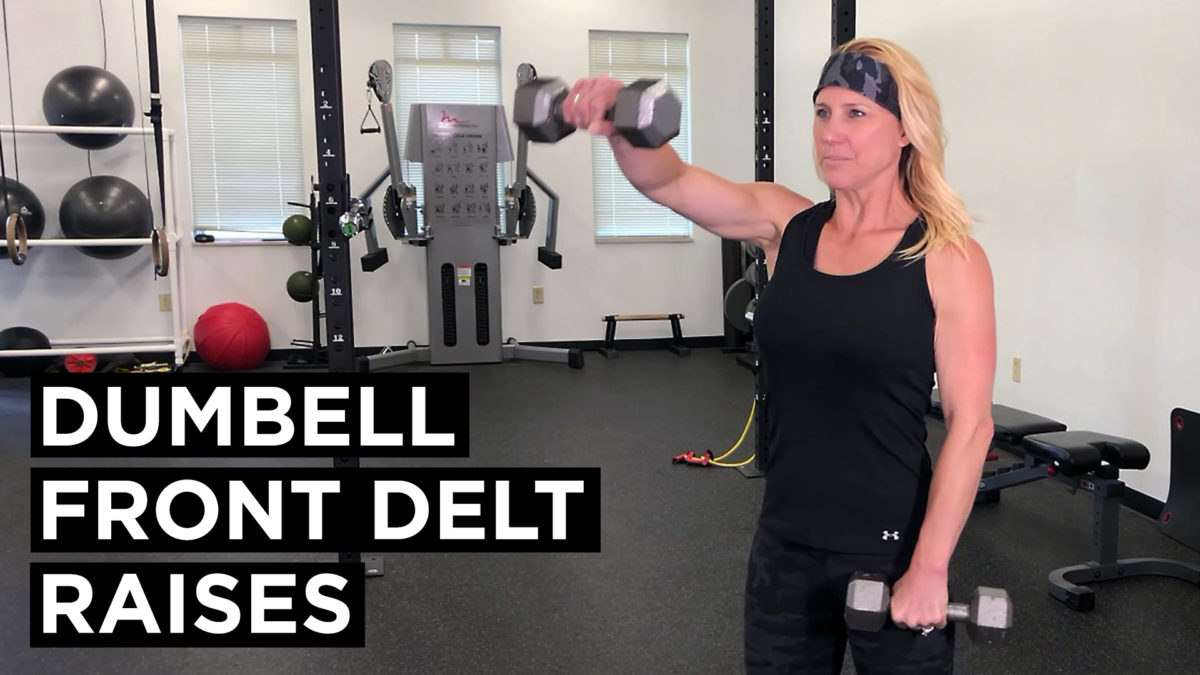Dumbell Front Raise Exercise Demonstration – Delt Front Raises
Targets:
Shoulder, upper chest
Equipment Needed:
Dumbbells
Level:
Beginner
The dumbbell front raise is a basic weight lifting exercise that is great for beginners through advanced weight lifters. In this version of the dumbbell front raise, you start with a dumbbell in each hand at thigh level. You raise the dumbbells parallel to the floor and then return to the starting position to complete one exercise repetition. You can use this exercise in an upper body workout to build your shoulder strength.
Benefits
The front raise strengthens primarily the shoulder (deltoids) but also works the upper chest muscles (pectorals). It is an isolation exercise for shoulder flexion. This exercise will help you build strength and definition in the front and sides of your shoulder. This exercise may also be recommended for physical therapy when recovering from a shoulder injury or shoulder surgery. In daily life, you need strong shoulders to lift objects safely.
Step-by-Step Instructions
The starting position – Select two dumbbells of a suitable weight. You must start with a light weight and plan to do 10 to 12 repetitions for one to three sets of exercises. A suggested starting weight for this exercise is with 5-pound dumbbells for women. Don’t lift weights that are too heavy.
– Stand with feet about shoulder-width apart. Keep the back straight and feet planted flat on the floor. Your arms holding weights should hang down.
– Hold the dumbbells across the thighs horizontally, palms facing back toward the thighs. Ensure that you have a firm grip.
– Brace the abdominal muscles.
– Lift the weights upward, inhaling, with arms out in front and palms facing down. Keep a slight bend in the elbows to reduce the stress on the joints.
– Pause when the arms are approximately horizontal to the floor and feelthe contraction in the shoulders.
– Return the dumbbells to the starting position at the thighs with a slow and controlled motion while exhaling.
– Repeat the exercise for the number of sets and repetitions in your program.

Marci Purcey demonstrates the DB Front Raise Exercise
Common Mistakes – Avoid these errors of form when performing delt front raise exercise.
Rocking
When performing this lift, do not rock or sway—always keep a strong and stationary torso. If you sway or find that you are rocking back on your heels in order to complete the lift, for example, then the weights are probably too heavy. Try performing this exercise alternating lifting with each arm if you find yourself rocking. Once you are stable doing it that way, you might try again doing both arms together.
Using Momentum
Don’t use momentum to lift the weights as this reduces the effectiveness of the exercise. Hoisting the weights quickly allows momentum to reduce the tension within the muscles, especially at the top of the lift.
Too Heavy of Weight
This is an exercise where you should not lift weights that cause you to fail completely at the end of a set. Don’t load the shoulder joint excessively as it can stress the joint and lead to injury.
Weak Core
Keep the back straight and brace the abdominals rather than performing with a rounded back and slack abs.
Wrist Position
Your wrists should be in a neutral position, not bent up or down. If you find you can’t maintain a neutral position, the weights are too heavy.
Modifications and Variations
This exercise can be performed in different ways:
You can perform front raises by alternating your arms, lifting and lowering them one at a time.
A barbell may also be used with this exercise. Start with light weight to become accustomed to the motion with the barbell. You could also use a weight plate or resistance bands to perform this movement.
Need a Modification?
If you feel any strain on the shoulder joint or have difficulty lifting the weights to shoulder level, reduce the weight of the dumbbells.
A hammer grip can be used. In this version, the dumbbells are held at the sides with a hammer grip (palms facing in toward each other), rather than flat on the thighs. The American Council on Exercise says this is a better choice to prevent shoulder impingement.
If you have difficulty standing, you can perform this exercise while seated. Be sure that you maintain a straight back and brace your abs.
Up for a Challenge?
If you can lift the weights with no difficulty or stress, you can gradually increase the weight.
You can perform this exercise while standing on a stability disc to give yourself a balance challenge. However, this should only be done if you have perfected your form.

